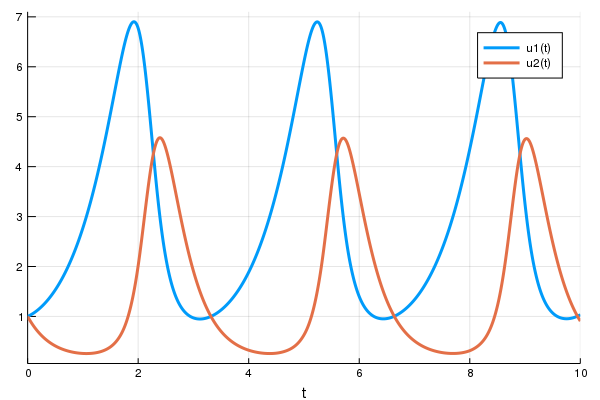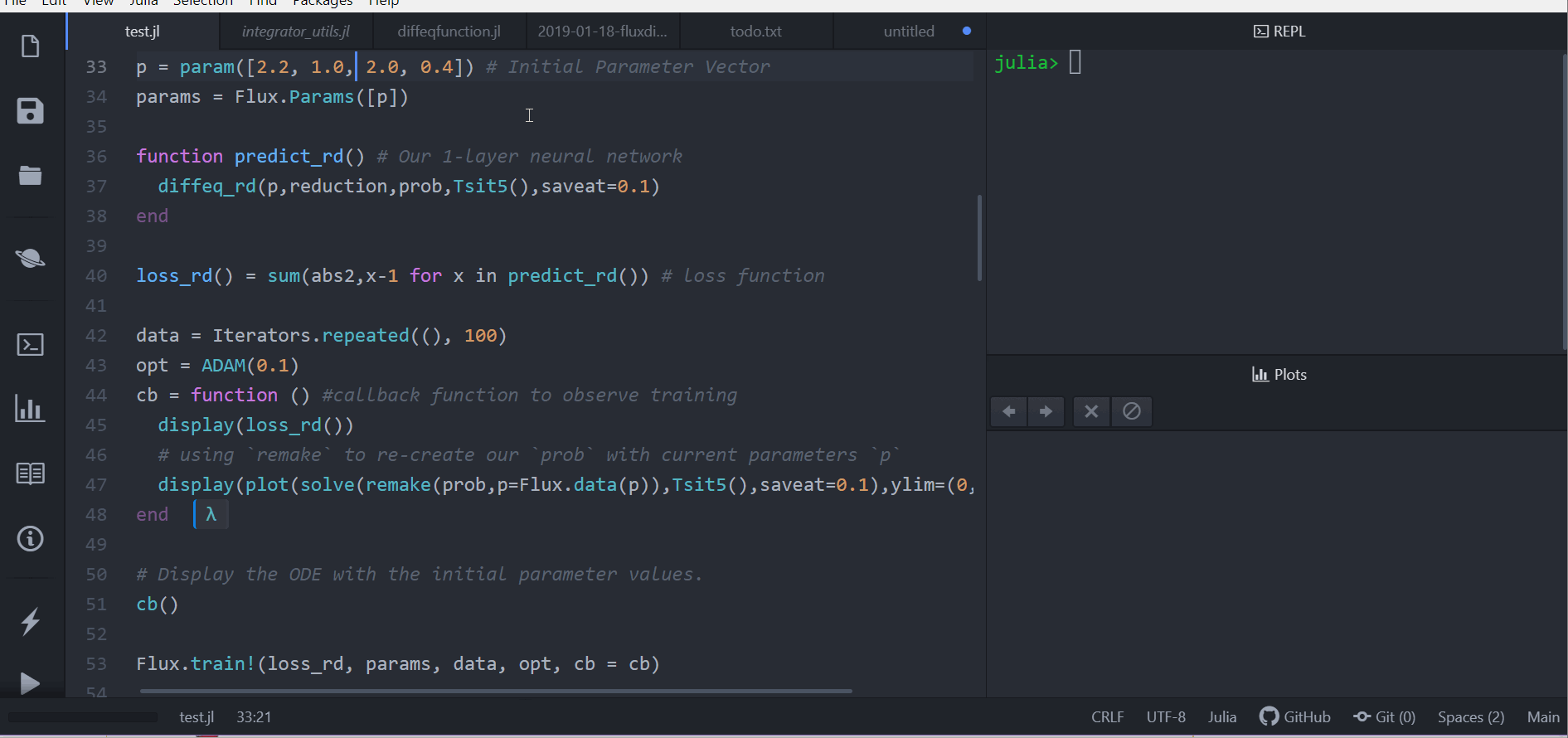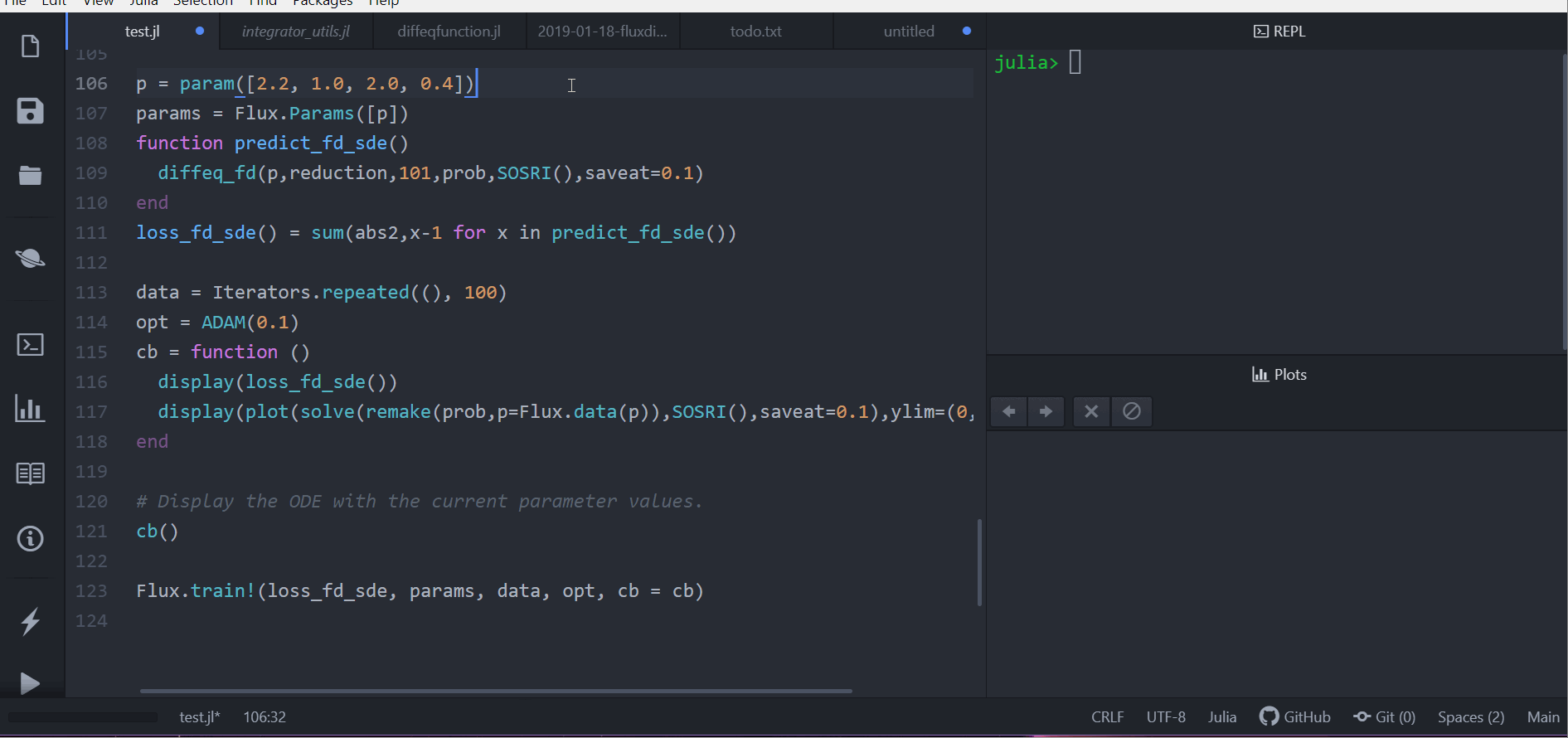DiffEqFlux.jl fuses the world of differential equations with machine learning by helping users put diffeq solvers into neural networks. This package utilizes DifferentialEquations.jl and Flux.jl as its building blocks to support research in Scientific Machine Learning and neural differential equations in traditional machine learning.
DiffEqFlux.jl is not just for neural ordinary differential equations. DiffEqFlux.jl is for neural differential equations. As such, it is the first package to support and demonstrate:
- Stiff neural ordinary differential equations (neural ODEs)
- Neural stochastic differential equations (neural SDEs)
- Neural delay differential equations (neural DDEs)
- Neural partial differential equations (neural PDEs)
- Neural jump stochastic differential equations (neural jump diffusions)
with high order, adaptive, implicit, GPU-accelerated, Newton-Krylov, etc. methods. For examples, please refer to the release blog post. Additional demonstrations, like neural PDEs and neural jump SDEs, can be found at this blog post (among many others!).
Do not limit yourself to the current neuralization. With this package, you can explore various ways to integrate the two methodologies:
- Neural networks can be defined where the “activations” are nonlinear functions described by differential equations.
- Neural networks can be defined where some layers are ODE solves
- ODEs can be defined where some terms are neural networks
- Cost functions on ODEs can define neural networks
If you use DiffEqFlux.jl or are influenced by its ideas for expanding beyond neural ODEs, please cite:
@article{DBLP:journals/corr/abs-1902-02376,
author = {Christopher Rackauckas and
Mike Innes and
Yingbo Ma and
Jesse Bettencourt and
Lyndon White and
Vaibhav Dixit},
title = {DiffEqFlux.jl - {A} Julia Library for Neural Differential Equations},
journal = {CoRR},
volume = {abs/1902.02376},
year = {2019},
url = {http://arxiv.org/abs/1902.02376},
archivePrefix = {arXiv},
eprint = {1902.02376},
timestamp = {Tue, 21 May 2019 18:03:36 +0200},
biburl = {https://dblp.org/rec/bib/journals/corr/abs-1902-02376},
bibsource = {dblp computer science bibliography, https://dblp.org}
}
For an overview of what this package is for, see this blog post.
First let's create a Lotka-Volterra ODE using DifferentialEquations.jl. For more details, see the DifferentialEquations.jl documentation
using DifferentialEquations
function lotka_volterra(du,u,p,t)
x, y = u
α, β, δ, γ = p
du[1] = dx = α*x - β*x*y
du[2] = dy = -δ*y + γ*x*y
end
u0 = [1.0,1.0]
tspan = (0.0,10.0)
p = [1.5,1.0,3.0,1.0]
prob = ODEProblem(lotka_volterra,u0,tspan,p)
sol = solve(prob,Tsit5())
using Plots
plot(sol)Next we define a single layer neural network that uses the diffeq_adjoint layer
function that takes the parameters and returns the solution of the x(t)
variable. Note that the diffeq_adjoint is usually preferred for ODEs, but does not
extend to other differential equation types (see the performance discussion section for
details). Instead of being a function of the parameters, we will wrap our
parameters in param to be tracked by Flux:
using Flux, DiffEqFlux
p = param([2.2, 1.0, 2.0, 0.4]) # Initial Parameter Vector
params = Flux.Params([p])
function predict_adjoint() # Our 1-layer neural network
diffeq_adjoint(p,prob,Tsit5(),saveat=0.0:0.1:10.0)
endNext we choose a loss function. Our goal will be to find parameter that make
the Lotka-Volterra solution constant x(t)=1, so we defined our loss as the
squared distance from 1:
loss_adjoint() = sum(abs2,x-1 for x in predict_adjoint())Lastly, we train the neural network using Flux to arrive at parameters which optimize for our goal:
data = Iterators.repeated((), 100)
opt = ADAM(0.1)
cb = function () #callback function to observe training
display(loss_adjoint())
# using `remake` to re-create our `prob` with current parameters `p`
display(plot(solve(remake(prob,p=Flux.data(p)),Tsit5(),saveat=0.0:0.1:10.0),ylim=(0,6)))
end
# Display the ODE with the initial parameter values.
cb()
Flux.train!(loss_adjoint, params, data, opt, cb = cb)Note that by using anonymous functions, this diffeq_adjoint can be used as a
layer in a neural network Chain, for example like
m = Chain(
Conv((2,2), 1=>16, relu),
x -> maxpool(x, (2,2)),
Conv((2,2), 16=>8, relu),
x -> maxpool(x, (2,2)),
x -> reshape(x, :, size(x, 4)),
# takes in the ODE parameters from the previous layer
p -> diffeq_adjoint(p,prob,Tsit5(),saveat=0.1),
Dense(288, 10), softmax) |> gpuor
m = Chain(
Dense(28^2, 32, relu),
# takes in the initial condition from the previous layer
x -> diffeq_rd(p,prob,Tsit5(),saveat=0.1,u0=x)),
Dense(32, 10),
softmax)Similarly, diffeq_adjoint, a O(1) memory adjoint implementation, can be
replaced with diffeq_rd for reverse-mode automatic differentiation or
diffeq_fd for forward-mode automatic differentiation. diffeq_fd will
be fastest with small numbers of parameters, while diffeq_adjoint will
be the fastest when there are large numbers of parameters (like with a
neural ODE). See the layer API documentation for details.
Other differential equation problem types from DifferentialEquations.jl are supported. For example, we can build a layer with a delay differential equation like:
function delay_lotka_volterra(du,u,h,p,t)
x, y = u
α, β, δ, γ = p
du[1] = dx = (α - β*y)*h(p,t-0.1)[1]
du[2] = dy = (δ*x - γ)*y
end
h(p,t) = ones(eltype(p),2)
prob = DDEProblem(delay_lotka_volterra,[1.0,1.0],h,(0.0,10.0),constant_lags=[0.1])
p = param([2.2, 1.0, 2.0, 0.4])
params = Flux.Params([p])
function predict_rd_dde()
Array(diffeq_rd(p,prob,MethodOfSteps(Tsit5()),saveat=0.1))
end
loss_rd_dde() = sum(abs2,x-1 for x in predict_rd_dde())
loss_rd_dde()Notice that we used mutating reverse-mode to handle a small delay differential equation, a strategy that can be good for small equations (see the performance discussion for more details on other forms).
Or we can use a stochastic differential equation. Here we demonstrate
diffeq_fd for forward-mode automatic differentiation of a small differential
equation:
function lotka_volterra_noise(du,u,p,t)
du[1] = 0.1u[1]
du[2] = 0.1u[2]
end
prob = SDEProblem(lotka_volterra,lotka_volterra_noise,[1.0,1.0],(0.0,10.0))
p = param([2.2, 1.0, 2.0, 0.4])
params = Flux.Params([p])
function predict_fd_sde()
diffeq_fd(p,Array,202,prob,SOSRI(),saveat=0.1)
end
loss_fd_sde() = sum(abs2,x-1 for x in predict_fd_sde())
loss_fd_sde()
data = Iterators.repeated((), 100)
opt = ADAM(0.1)
cb = function ()
display(loss_fd_sde())
display(plot(solve(remake(prob,p=Flux.data(p)),SOSRI(),saveat=0.1),ylim=(0,6)))
end
# Display the ODE with the current parameter values.
cb()
Flux.train!(loss_fd_sde, params, data, opt, cb = cb)We can use DiffEqFlux.jl to define, solve, and train neural ordinary differential
equations. A neural ODE is an ODE where a neural network defines its derivative
function. Thus for example, with the multilayer perceptron neural network
Chain(Dense(2,50,tanh),Dense(50,2)), the best way to define a neural ODE by hand
would be to use non-mutating adjoints, which looks like:
p = DiffEqFlux.destructure(model)
dudt_(u::TrackedArray,p,t) = DiffEqFlux.restructure(model,p)(u)
dudt_(u::AbstractArray,p,t) = Flux.data(DiffEqFlux.restructure(model,p)(u))
prob = ODEProblem(dudt_,x,tspan,p)
my_neural_ode_prob = diffeq_adjoint(p,prob,args...;u0=x,kwargs...)(DiffEqFlux.restructure and DiffEqFlux.destructure are helper functions
which transform the neural network to use parameters p)
A convenience function which handles all of the details is neural_ode. To
use neural_ode, you give it the initial condition, the internal neural
network model to use, the timespan to solve on, and any ODE solver arguments.
For example, this neural ODE would be defined as:
tspan = (0.0f0,25.0f0)
x -> neural_ode(model,x,tspan,Tsit5(),saveat=0.1)where here we made it a layer that takes in the initial condition and spits out an array for the time series saved at every 0.1 time steps.
Let's get a time series array from the Lotka-Volterra equation as data:
u0 = Float32[2.; 0.]
datasize = 30
tspan = (0.0f0,1.5f0)
function trueODEfunc(du,u,p,t)
true_A = [-0.1 2.0; -2.0 -0.1]
du .= ((u.^3)'true_A)'
end
t = range(tspan[1],tspan[2],length=datasize)
prob = ODEProblem(trueODEfunc,u0,tspan)
ode_data = Array(solve(prob,Tsit5(),saveat=t))Now let's define a neural network with a neural_ode layer. First we define
the layer:
dudt = Chain(x -> x.^3,
Dense(2,50,tanh),
Dense(50,2))
n_ode(x) = neural_ode(dudt,x,tspan,Tsit5(),saveat=t,reltol=1e-7,abstol=1e-9)Here we used the x -> x.^3 assumption in the model. By incorporating structure
into our equations, we can reduce the required size and training time for the
neural network, but a good guess needs to be known!
From here we build a loss function around it. We will use the L2 loss of the network's output against the time series data:
function predict_n_ode()
n_ode(u0)
end
loss_n_ode() = sum(abs2,ode_data .- predict_n_ode())and then train the neural network to learn the ODE:
data = Iterators.repeated((), 1000)
opt = ADAM(0.1)
cb = function () #callback function to observe training
display(loss_n_ode())
# plot current prediction against data
cur_pred = Flux.data(predict_n_ode())
pl = scatter(t,ode_data[1,:],label="data")
scatter!(pl,t,cur_pred[1,:],label="prediction")
display(plot(pl))
end
# Display the ODE with the initial parameter values.
cb()
ps = Flux.params(dudt)
Flux.train!(loss_n_ode, ps, data, opt, cb = cb)Note that the differential equation solvers will run on the GPU if the initial condition is a GPU array. Thus for example, we can define a neural ODE by hand that runs on the GPU:
u0 = Float32[2.; 0.] |> gpu
dudt = Chain(Dense(2,50,tanh),Dense(50,2)) |> gpu
p = DiffEqFlux.destructure(model)
dudt_(u::TrackedArray,p,t) = DiffEqFlux.restructure(model,p)(u)
dudt_(u::AbstractArray,p,t) = Flux.data(DiffEqFlux.restructure(model,p)(u))
prob = ODEProblem(ODEfunc, u0,tspan)
# Runs on a GPU
sol = solve(prob,Tsit5(),saveat=0.1)and the diffeq layer functions can be used similarly. Or we can directly use
the neural ODE layer function, like:
x -> neural_ode(gpu(dudt),gpu(x),tspan,Tsit5(),saveat=0.1)You can also mix a known differential equation and a neural differential equation, so that the parameters and the neural network are estimated simultaniously. Here's an example of doing this with both reverse-mode autodifferentiation and with adjoints:
using DiffEqFlux, Flux, OrdinaryDiffEq
## --- Reverse-mode AD ---
tspan = (0.0f0,25.0f0)
u0 = Tracker.param(Float32[0.8; 0.8])
ann = Chain(Dense(2,10,tanh), Dense(10,1))
p = param(Float32[-2.0,1.1])
function dudt_(u::TrackedArray,p,t)
x, y = u
Flux.Tracker.collect(
[ann(u)[1],
p[1]*y + p[2]*x*y])
end
function dudt_(u::AbstractArray,p,t)
x, y = u
[Flux.data(ann(u)[1]),
p[1]*y + p[2]*x*y]
end
prob = ODEProblem(dudt_,u0,tspan,p)
diffeq_rd(p,prob,Tsit5())
function predict_rd()
Flux.Tracker.collect(diffeq_rd(p,prob,Tsit5(),u0=u0))
end
loss_rd() = sum(abs2,x-1 for x in predict_rd())
loss_rd()
data = Iterators.repeated((), 10)
opt = ADAM(0.1)
cb = function ()
display(loss_rd())
#display(plot(solve(remake(prob,u0=Flux.data(u0),p=Flux.data(p)),Tsit5(),saveat=0.1),ylim=(0,6)))
end
# Display the ODE with the current parameter values.
cb()
Flux.train!(loss_rd, params(ann,p,u0), data, opt, cb = cb)
## --- Partial Neural Adjoint ---
u0 = param(Float32[0.8; 0.8])
tspan = (0.0f0,25.0f0)
ann = Chain(Dense(2,10,tanh), Dense(10,1))
p1 = Flux.data(DiffEqFlux.destructure(ann))
p2 = Float32[-2.0,1.1]
p3 = param([p1;p2])
ps = Flux.params(p3,u0)
function dudt_(du,u,p,t)
x, y = u
du[1] = DiffEqFlux.restructure(ann,p[1:41])(u)[1]
du[2] = p[end-1]*y + p[end]*x
end
prob = ODEProblem(dudt_,u0,tspan,p3)
diffeq_adjoint(p3,prob,Tsit5(),u0=u0,abstol=1e-8,reltol=1e-6)
function predict_adjoint()
diffeq_adjoint(p3,prob,Tsit5(),u0=u0,saveat=0.0:0.1:25.0)
end
loss_adjoint() = sum(abs2,x-1 for x in predict_adjoint())
loss_adjoint()
data = Iterators.repeated((), 10)
opt = ADAM(0.1)
cb = function ()
display(loss_adjoint())
#display(plot(solve(remake(prob,p=Flux.data(p3),u0=Flux.data(u0)),Tsit5(),saveat=0.1),ylim=(0,6)))
end
# Display the ODE with the current parameter values.
cb()
Flux.train!(loss_adjoint, ps, data, opt, cb = cb)With neural stochastic differential equations, there is once again a helper form neural_dmsde which can
be used for the multiplicative noise case (consult the layers API documentation, or
this full example using the layer function).
However, since there are far too many possible combinations for the API to support, in many cases you will want to
performantly define neural differential equations for non-ODE systems from scratch. For these systems, it is generally
best to use diffeq_rd with non-mutating (out-of-place) forms. For example, the following defines a neural SDE with
neural networks for both the drift and diffusion terms:
dudt_(u,p,t) = model(u)
g(u,p,t) = model2(u)
prob = SDEProblem(dudt_,g,param(x),tspan,nothing)where model and model2 are different neural networks. The same can apply to a neural delay differential equation.
Its out-of-place formulation is f(u,h,p,t). Thus for example, if we want to define a neural delay differential equation
which uses the history value at p.tau in the past, we can define:
dudt_(u,h,p,t) = model([u;h(t-p.tau)])
prob = DDEProblem(dudt_,u0,h,tspan,nothing)First let's build training data from the same example as the neural ODE:
using Flux, DiffEqFlux, StochasticDiffEq, Plots, DiffEqBase.EnsembleAnalysis
u0 = Float32[2.; 0.]
datasize = 30
tspan = (0.0f0,1.0f0)
function trueODEfunc(du,u,p,t)
true_A = [-0.1 2.0; -2.0 -0.1]
du .= ((u.^3)'true_A)'
end
t = range(tspan[1],tspan[2],length=datasize)
mp = Float32[0.2,0.2]
function true_noise_func(du,u,p,t)
du .= mp.*u
end
prob = SDEProblem(trueODEfunc,true_noise_func,u0,tspan)For our dataset we will use DifferentialEquations.jl's parallel ensemble interface to generate data from the average of 100 runs of the SDE:
# Take a typical sample from the mean
ensemble_prob = EnsembleProblem(prob)
ensemble_sol = solve(ensemble_prob,SOSRI(),trajectories = 100)
ensemble_sum = EnsembleSummary(ensemble_sol)
sde_data = Array(timeseries_point_mean(ensemble_sol,t))Now we build a neural SDE. For simplicity we will use the neural_dmsde
multiplicative noise neural SDE layer function:
dudt = Chain(x -> x.^3,
Dense(2,50,tanh),
Dense(50,2))
ps = Flux.params(dudt)
n_sde = x->neural_dmsde(dudt,x,mp,tspan,SOSRI(),saveat=t,reltol=1e-1,abstol=1e-1)Let's see what that looks like:
pred = n_sde(u0) # Get the prediction using the correct initial condition
dudt_(u,p,t) = Flux.data(dudt(u))
g(u,p,t) = mp.*u
nprob = SDEProblem(dudt_,g,u0,(0.0f0,1.2f0),nothing)
ensemble_nprob = EnsembleProblem(nprob)
ensemble_nsol = solve(ensemble_nprob,SOSRI(),trajectories = 100)
ensemble_nsum = EnsembleSummary(ensemble_nsol)
p1 = plot(ensemble_nsum, title = "Neural SDE: Before Training")
scatter!(p1,t,sde_data',lw=3)
scatter(t,sde_data[1,:],label="data")
scatter!(t,Flux.data(pred[1,:]),label="prediction")Now just as with the neural ODE we define a loss function:
function predict_n_sde()
n_sde(u0)
end
loss_n_sde1() = sum(abs2,sde_data .- predict_n_sde())
loss_n_sde10() = sum([sum(abs2,sde_data .- predict_n_sde()) for i in 1:10])
Flux.back!(loss_n_sde1())
data = Iterators.repeated((), 10)
opt = ADAM(0.025)
cb = function () #callback function to observe training
sample = predict_n_sde()
# loss against current data
display(sum(abs2,sde_data .- sample))
# plot current prediction against data
cur_pred = Flux.data(sample)
pl = scatter(t,sde_data[1,:],label="data")
scatter!(pl,t,cur_pred[1,:],label="prediction")
display(plot(pl))
end
# Display the SDE with the initial parameter values.
cb()Here we made two loss functions: one which uses single runs of the SDE and another which uses multiple runs. This is beceause an SDE is stochastic, so trying to fit the mean to high precision may require a taking the mean of a few trajectories (the more trajectories the more precise the calculation is). Thus to fit this, we first get in the general area through single SDE trajectory backprops, and then hone in with the mean:
Flux.train!(loss_n_sde1 , ps, Iterators.repeated((), 100), opt, cb = cb)
Flux.train!(loss_n_sde10, ps, Iterators.repeated((), 20), opt, cb = cb)And now we plot the solution to an ensemble of the trained neural SDE:
dudt_(u,p,t) = Flux.data(dudt(u))
g(u,p,t) = mp.*u
nprob = SDEProblem(dudt_,g,u0,(0.0f0,1.2f0),nothing)
ensemble_nprob = EnsembleProblem(nprob)
ensemble_nsol = solve(ensemble_nprob,SOSRI(),trajectories = 100)
ensemble_nsum = EnsembleSummary(ensemble_nsol)
p2 = plot(ensemble_nsum, title = "Neural SDE: After Training", xlabel="Time")
scatter!(p2,t,sde_data',lw=3,label=["x" "y" "z" "y"])
plot(p1,p2,layout=(2,1))(note: for simplicity we have used a constant mp vector, though once can param and
train this value as well.)
Try this with GPUs as well!
For the sake of not having a never-ending documentation of every single combination of CPU/GPU with every layer and every neural differential equation, we will end here. But you may want to consult this blog post which showcases defining neural jump diffusions and neural partial differential equations.
DiffEqFlux.jl implements all interactions of automatic differentiation systems to satisfy completeness, but that does not mean that every combination is a good combination.
- Use
diffeq_adjointwith an out-of-place non-mutating functionf(u,p,t)on ODEs without events. - Use
diffeq_rdwith an out-of-place non-mutating function (f(u,p,t)on ODEs/SDEs,f(du,u,p,t)for DAEs,f(u,h,p,t)for DDEs, and consult the docs for other equations) for non-ODE neural differential equations or ODEs with events - If the neural network is a sufficiently small (or non-existant) part of the differential equation, consider
diffeq_fdwith the mutating form (f(du,u,p,t)). - Always use GPUs if the majority of the time is in larger kernels (matrix multiplication, PDE convolutions, etc.)
The major options to keep in mind are:
- in-place vs out-of-place: for ODEs this amounts to
f(du,u,p,t)mutatingduvsdu = f(u,p,t). In almost all scientific computing scenarios with floating point numbers,f(du,u,p,t)is highly preferred. This extends to dual numbers and thus forward difference (diffeq_fd). However, reverse-mode automatic differentiation as implemented by Flux.jl's Tracker.jl does not allow for mutation on itsTrackedArraytype, meaning that mutation is supported byArray{TrackedReal}. This fallback is exceedingly slow due to the large trace that is created, and thus out-of-place (f(u,p,t)for ODEs) is preferred in this case. - For adjoints, this fact is complicated due to the choices in the
SensitivityAlg. See the adjoint SensitivityAlg options for more details. Whenautojacvec=true, a backpropogation is performed by Tracker in the intermediate steps, meaning the rule about mutation applies. However, the majority of the computation is not htev^T*Jcomputation of the backpropogation, so it is not always obvious to determine the best option given that mutation is slow for backprop but is much faster for large ODEs with many scalar operations. But the latter portion of that statement is the determiner: if there are sufficiently large operations which are dominating the runtime, then the backpropogation can be made trivial by using mutation, and thusf(u,p,t)is more efficient. One example which falls into this case is the neural ODE which has large matrix multiply operations. However, if the neural network is a small portion of the equation and there is heavy reliance on directly specified nonlinear forms in the differential equation,f(du,u,p,t)with the optionsense=SensitivityAlg(autojacvec=false)may be preferred. diffeq_adjointcurrently only applies to ODEs, though continued development will handle other equations in the future.diffeq_adjointhas O(1) memory with the defaultbacksolve. However, it is known that this is unstable on many equations with high enough stiffness (this is a fundamental fact of the numerics, see the blog post for details and an example. Likewise, this instability is not often seen when training a neural ODE against real data. Thus it is recommended to try with the default options first, and then setbacksolve=falseif unstable gradients are found. Whenbacksolve=falseis set, this will trigger theSensitivityAlgto use checkpointed adjoints, which are more stable but take more computation.- When the equation has small enough parameters, or they are not confined to large operations,
diffeq_fdwill be the fastest. However, as it is well-known, forward-mode AD does not scale well for calculating the gradient with respect to large numbers of parameters, and thus it will not scale well in cases like the neural ODE.
diffeq_rd(p,prob, args...;u0 = prob.u0, kwargs...)uses Flux.jl's reverse-mode AD through the differential equation solver with parameterspand initial conditionu0. The rest of the arguments are passed to the differential equation solver. The return is the DESolution. Note: if you use this function, it is much better to use the allocating out of place form (f(u,p,t)for ODEs) than the in place form (f(du,u,p,t)for ODEs)!diffeq_fd(p,reduction,n,prob,args...;u0 = prob.u0, kwargs...)uses ForwardDiff.jl's forward-mode AD through the differential equation solver with parameterspand initial conditionu0.nis the output size where the return value isreduction(sol). The rest of the arguments are passed to the differential equation solver.diffeq_adjoint(p,prob,args...;u0 = prob.u0, kwargs...)uses adjoint sensitivity analysis to "backprop the ODE solver" via DiffEqSensitivity.jl. The return is the time series of the solution as an array solved with parameterspand initial conditionu0. The rest of the arguments are passed to the differential equation solver or handled by the adjoint sensitivity algorithm (for more details on sensitivity arguments, see the diffeq documentation).
neural_ode(model,x,tspan,args...;kwargs...)defines a neural ODE layer wheremodelis a Flux.jl model,xis the initial condition,tspanis the time span to integrate, and the rest of the arguments are passed to the ODE solver. The parameters should be implicit in themodel.neural_dmsde(model,x,mp,tspan,args...;kwargs)defines a neural multiplicative SDE layer wheremodelis a Flux.jl model,xis the initial condition,tspanis the time span to integrate, and the rest of the arguments are passed to the SDE solver. The noise is assumed to be diagonal multiplicative, i.e. the Wiener term ismp.*u.*dWfor some array of noise constantsmp.



